Training on a paddleboard requires you to stabilize your body to maintain balance. Working your stabilizing muscles is beneficial for diving because they are helpful in dynamic ocean environments.
Aim to repeat this circuit three times to complete the workout. You may drift throughout the workout, so use the time between exercises to paddle back to your starting location as needed. Sprinting back to the starting position instead of leisurely paddling can enhance your workout if you are up for the challenge.
Stand-up paddleboards (SUPs) come in various shapes and sizes. You can use whatever type of board you have access to, but there are some considerations for stability. Wider boards are generally more stable, while longer boards are typically faster. The longer the fins, the more stable the board. If you use an inflatable paddleboard, use the highest recommended pressure for that board for maximum stability.
There are some safety considerations when training on an SUP. Always check the water to make sure the location is safe, and stay away from boat traffic or challenging currents. Bring a flotation device if you are in open water. Ensure you have sufficient clearance between yourself and any dangerous objects in case you fall off the board. Falling into the water will cool you off, but falling into a dock or a submerged object can be dangerous.
Quadruped
- Begin centered on your paddleboard on all fours with your hands under your shoulders. Your knees should be under your hips and in line with the handle in the middle of the board. Place the paddle across the board in front of you.
- Hold the paddle in your right hand, and extend your right hand and left leg. Reach as far as you can with your hand and foot.
- Bring your right elbow and left knee toward each other until they touch.
- Repeat the entire movement in a slow, controlled manner 10 times.
- Repeat the sequence with your left arm and right leg.
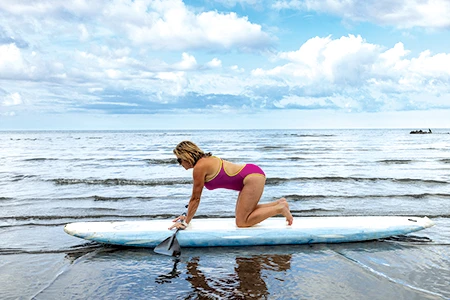
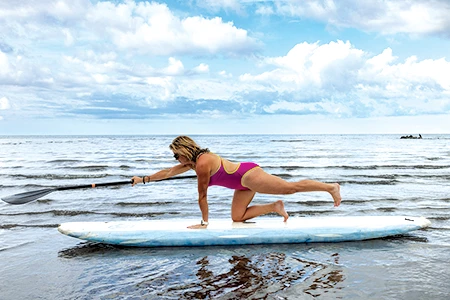
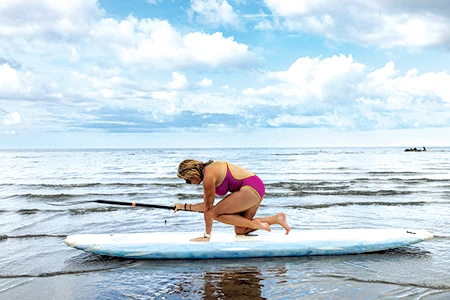
Modification: Try raising your arm first and then your leg.
Challenge: Lift and squeeze your arm and leg when fully extended.
Kneeling Quad Raises
- Kneel on your paddleboard, holding the paddle across your board with both hands.
- Sit back and hover your glutes as close to your lower legs as possible without touching them.
- Rise back to a kneeling position while raising the paddle overhead with straight arms.
- Complete 10 slow, controlled repetitions.
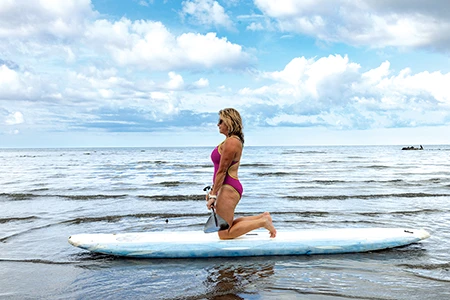
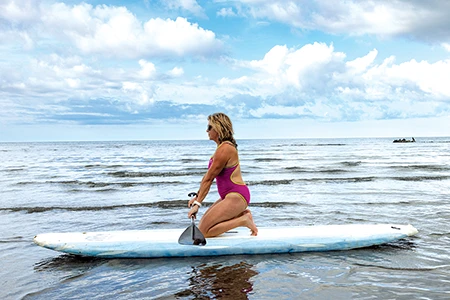
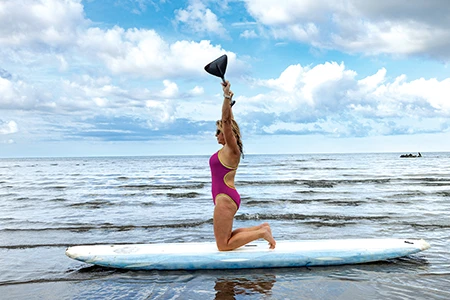
Modification: Lower your glutes only slightly toward your legs.
Challenge: Try to hold the low position for two to three breaths.
Low Lunge Side Bends
- Begin on all fours with your knees slightly behind the middle of the board.
- Place your right foot between your hands in a low lunge position with a wide stance, adjusting to maintain your balance.
- Hold your paddle above your head with both hands shoulder-width apart.
- Bend to your right until your paddle touches the water, and then return to the upright position.
- Do the same movement to the left.
- Complete 10 slow, controlled repetitions.
- Repeat the sequence with the left foot forward in the lunge.
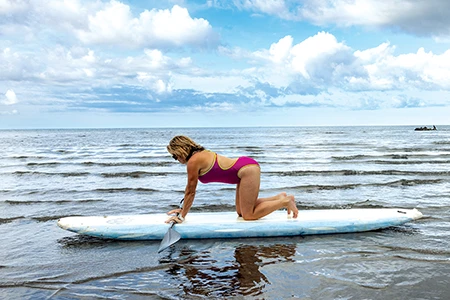

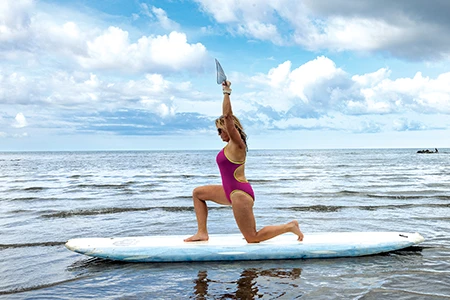
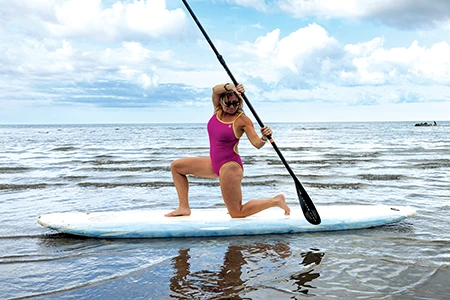
Modification: Don’t lower your paddle all the way to the water.
Challenge: Try this movement in a high lunge position, rising on your back foot instead of your knee.
Board Burpees
- Begin standing with your feet shoulder-width apart and your paddle in front of you.
- Bend down, placing your paddle across the board.
- Lay prone on your stomach on the board.
- Jump up to a low goblet squat position.
- Stand up, raising your paddle overhead.
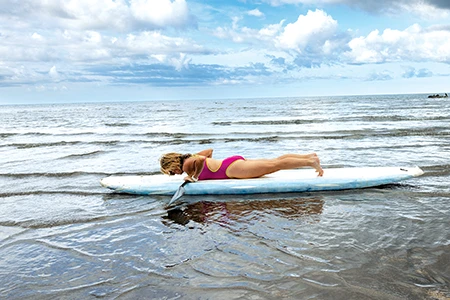
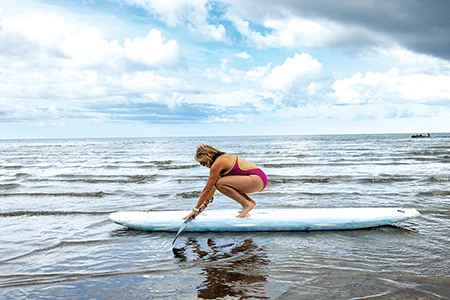
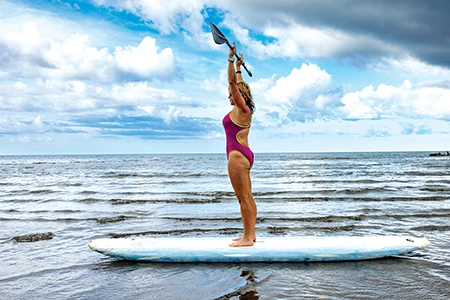
Modification: Step into instead of jumping to the squat position.
Challenge: Add a push-up while you are in the prone position.
Squat Paddle
- Stand with your feet shoulder-width apart, and hold the paddle with both hands, ready to paddle.
- Squat to as close to 90 degrees as you are comfortable.
- Paddle three strokes on your left and three strokes on your right.
- Repeat the paddling 10 times, and then stand up.
Modification: Reduce the depth of your squat.
Challenge: Continue paddling for a full minute.
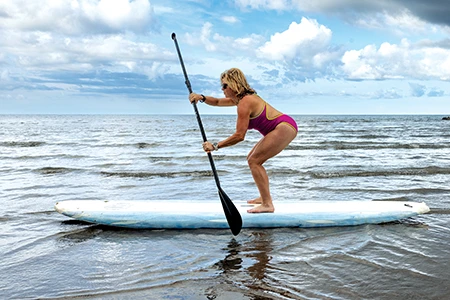
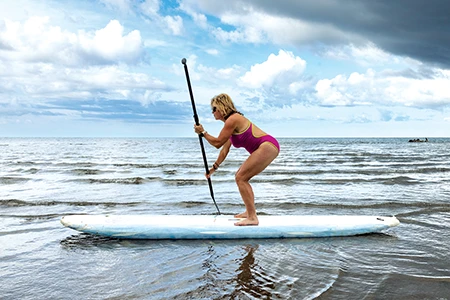
Downward Dog to Push-Up
- Begin balanced on all fours on your board with the paddle across it.
- Lift your knees so they hover slightly over the board, holding the position for 10 seconds.
- Press onto your feet into a downward dog position.
- Pedal your heels 10 times.
- Transition to a plank position, and complete one push-up.
- Press back to downward dog.
- Repeat the sequence 10 times.



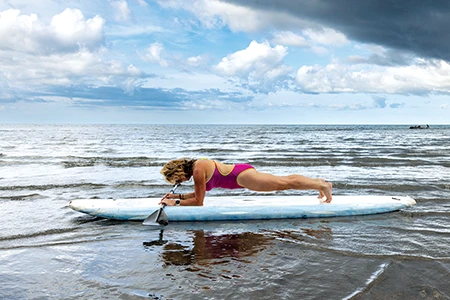
Modification: Do the push-up on your knees.
Challenge: Hold the low position of each push-up for two to three breaths.
NOTE: To avoid an increased risk of decompression sickness, DAN® recommends that divers avoid strenuous exercise for 24 hours after making a dive. During your annual physical exam or following any changes in your health status, consult your physician to ensure you have medical clearance to dive.
© Alert Diver – Q4 2024